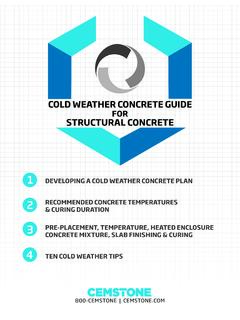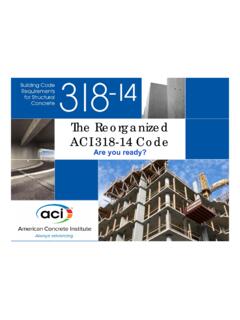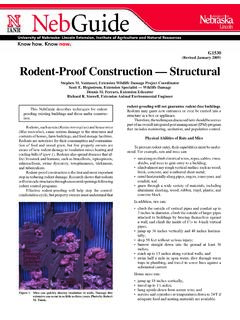Transcription of Cast-In-Place Concrete Parking Structures - CRSI
1 Cast-In-Place Concrete Parking Structures ADVANTAGES OF Cast-In-Place Concrete Parking Structures At the time of construction (1990), the Franklin/Van Buren Parking Facility, Chicago, IL. was the tallest self park in the world, providing Parking on 14 levels. This brochure contains case studies of 20 Parking Structures located throughout the United States. In most of these cases, a post-tensioned structural system was selected after careful economic studies and comparisons indicated initial or life cycle cost savings. In some cases, the initial costs were comparable to a competitive alternative, but life cycle cost comparisons or the other tangible advantages discussed below resulted in selection of post-tensioned Concrete structural frames. The Cast-In-Place Concrete structural system most commonly used for Parking Structures is a one way slab supported on beams.
2 The slabs typically have spans in the range of 17 ft to 27 ft. The beams usually have spans in the range of 50 ft to 62 ft. Most of the examples in this publication illustrate the beam and slab structural system. Two way flat plates and flat slabs are also used for Parking Structures as is illustrated on pages 10 and 31 to 33. An independent statistical analysis (1) * of Parking structure construction for 1986 to 1989 shows that Cast-In-Place post--tensioned Concrete structural solutions were most often selected. These are the reasons: INITIAL AND LIFE CYCLE COSTS Analyses and competitive bids against alter-native systems often show that post-tensioned structural systems provide initial cost savings. Alternative bids for the Indianapolis International Airport Parking Structure (see page 12) resulted in a savings of about $ per square foot for the post-tensioned alternative.
3 When initial costs are more nearly comparable, life cycle costs often show savings for post-tensioned alternatives. Quantities and cost information for the 20 case studies in this brochure are presented in the project summaries, pages 26-27. Additional quantities suitable for estimating purposes are presented on pages 31-33. LOW MAINTENANCE COST Properly constructed Cast-In-Place post-tensioned Concrete floors are virtually crack-free and use widely spaced floor joints (joint spacing of 200 ft or more are common). The use of epoxy-coated reinforcement, encapsulation of post-tensioned reinforcement, low water/cement ratio air-entrained Concrete , and Concrete sealers in aggressive environments provide floor systems with minimal maintenance costs. See the detailed discussion of durability on pages 28-30.
4 Precast floors, particularly untopped precast floors, require periodic maintenance repairs of the caulked joints *Numbers in raised () refer to references listed at the end of this section. HIGHEST QUALITY AT COMPETITIVE COSTS between the precast units. One consulting firm estimated that 30 percent of the caulked joints of precast floors will need to be replaced every three years after the five year warranty expires. Loss of Parking spaces during maintenance work results in loss of Parking revenue. CRACK CONTROL AND WATERTIGHTNESS In addition to elimination of caulked joints, post-tensioning helps achieve watertightness by introducing a state of bi-axial compression in the slab, thereby controlling cracks. That's an important advantage because water, dirt and de-icer chemicals leaking through cracks or joints may make parts of a Parking structure unusable or require costly repairs.
5 SMOOTH RIDING SURFACE The continuous riding surface with minimal joints provided by Cast-In-Place Concrete construction creates a superior riding quality since most join ts are eliminated and differential initial and long-term deflections across joints are not a concern. Cast-In-Place floors are also readily warped to provide smooth geometry transition between ramps and floors. ENHANCED LIGHTING AND PATRON SECURITY The wide beam spacing and flat surfaces pro-vided by Cast-In-Place Parking Structures enhance the installation and efficiency of the lighting system. This results in improved esthetics and enhanced patron security. Riding surface of Xerox Centre Parking Structure (Phase 1), Santa Ana, CAFIRE RESISTANCE The fire resistive characteristics of the flat surfaces and wide beams of post-tensioned Structures provide fire resistive ratings to meet code requirements.
6 Thin-stemmed structural elements provide less Concrete insulation to delay strength loss of the main reinforcement. This results in shorter fire resistive periods. Lighting of Franklin/Van Buren Self Park, Chicago. ADVANTAGES OF Cast-In-Place Structures are shown by the following project case studies. The ease with which architectural treatments of exposed Concrete are achieved is a definite advantage of Cast-In-Place Concrete Structures . A notable example is the Williams Square West Garage, Irving, Texas shown at the left. In this structure, the Concrete in exposed perimeter elements was made with a crushed granite aggregate. The Concrete for the interior beams, slabs and columns used a more economical crushed limestone aggregate. To fully reveal the color of the granite, perimeter surfaces were sandblasted.
7 REDUCED structural DEPTH Use of post-tensioning reduces the depth of the floor system by one-third or more in comparison to some alternative systems. Reduced structural depth enhances both the appearance and economy of post-tensioned Concrete Parking Structures . In some cases, such as the Sands Hotel/Casino Parking Structure on page 11, depth reduction was an essential factor in meeting code height restrictions. For the Douglas Parking Structure (see page 10), reduction in height of the Parking structure was a primary architectural consideration. For underground Parking Structures , reduced depth reduces excavation and shoring costs as well as improving Parking efficiency due to shorter ramps. DEFLECTION AND VIBRATION CONTROL Because of their draped configuration, the tendons in a post-tensioned structure carry much of the load directly to the columns.
8 This reduces flexural deflections in the framing system. Due to post-tensioning, the entire Concrete section is effective in resisting load effects. In conjunction with the redundancy of monolithic Concrete framing systems, this reduces vibrations of the completed structure. Williams Square WestGarage, Irving, TexasCrushed granite aggregateconcrete surface FLEXIBILITY Cast-In-Place , post-tensioned Concrete construction provides long, column-free spans and is easily adaptable to the framing and functional requirements of Parking Structures . Post-tensioned construction easily accommodates the framing requirements of straight ramps, curved ramps, and irregular sites. There is no functional compromise, which can be the case with other framing systems. ESTHETICS The architectural appeal of Cast-In-Place Concrete construction is widely recognized.
9 In fact, Structures with other framing systems often imitate Cast-In-Place Concrete parapets and fascia. Curvilinear shapes and forms economically achieveable in Cast-In-Place Structures provide the necessary flexibility for creative architectural expressions. The esthetic advantages of Cast-In-Place Concrete Parking Concrete CONSTRUCTION FRAME RESISTANCE TO LATERAL LOADS Monolithic connections between slabs, beam,, and columns provide a rigid frame with built-in resistance to wind and other lateral loads. The use of this inherent frame action in the Texas - Medical Center Parking Structure No. 7 (see page 22) eliminated the need for shear walls or bracing, even under hurricane wind loads. RESISTANCE TO SEISMIC LOADINGS Hundreds of post-tensioned Parking Structures performed well in the 1971 San Fernando earthquake (2) and in the 1989 Loma Prieta earthquake.
10 (3) Research has shown that unbonded post-tensioning improves the behavior of structural frames under seismic loadings. (4) Code provisions developed by the Building Seismic Safety Council now recognize the helpful effects of unbonded post-tensioning in ductile moment resisting frames. (5) structural INTEGRITY The 1989 ACI Building Code(6) introduced reinforcement requirements for structural integrity. These requirements insure a minimal resistance to abnormal or catastrophic loading conditions not contemplated in the routine design loadings. Both research and experience have shown that post-tensioned Structures inherently provide structural integrity under abnormal and even catastrophic loadings. (7) LOCAL LABOR AND MATERIALS The predominant use of local labor and ma-terials contributes to the low initial cost of Cast-In-Place Concrete Parking Structures .



